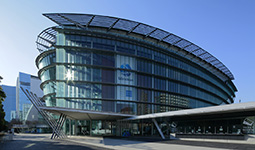Home > Highlighting JAPAN > Highlighting Japan January 2018 > Sustainable Technologies from Japan
Highlighting JAPAN


Inviting Ideas for Sustainable Rice Farming
In connection with the Science Centre World Summit 2017 (SCWS 2017) last November, the National Museum of Emerging Science and Innovation (Miraikan) hosted a special exhibition introducing attractive reflections and ideas on the sustainability of rice farming in Asia.
SCWS 2017 was held for the first time in Asia at Miraikan, in the Tokyo Rinkai area, from November 15 to 17, 2017. Developed under the main theme of “Connecting the World for a Sustainable Future,” SCWS 2017 was successfully concluded with the adoption of the “Tokyo Protocol,” a set of guidelines for the actions of science centers/museums worldwide to achieve the sustainable development goals (SDGs) to be followed until the next SCWS in 2020 (see here).
In connection with SCWS 2017, Miraikan organized the temporary exhibition “Beautiful Rice — For a Sustainable Future” from November 11, 2017 to January 8, 2018. The exhibition is a part of Miraikan’s original measures to help increase public awareness of and engagement in the SDGs.
The temporary exhibition introduces the cycle of substances used for rice farming from a scientific perspective with a focus on the traditional method of rice cultivation that has been conducted by farmers throughout many parts of Asia for thousands of years. It highlights lifestyles and culture closely linked to rice farming, such as cooking, festivals and folklore materials, as well as rice cultivation itself.
For example, there were photographs and illustrations of the lifestyles and culture closely linked to rice cultivation in Asian farming villages; the current situation of modern agriculture that has realized high productivity through the use of chemical fertilizers and large-scale farming, but is saddled with issues such as environmental problems and the decline of biodiversity; and the direction for sustainable food production including plant factories and circulation- based urban planning, which could be breakthroughs.
The purpose of the temporary exhibition is to help each visitor generate ideas for sustainable food production and how they will be able to eat delicious foods for the next 1,000 years. The exhibition is participation-oriented, with visitors being encouraged to think of best ways forward for rice farming, comparing the advantages and disadvantages of the environmental burden and the yield of rice farming and harvesting using imaginary scenarios, such as “rice grown on Mars” or “rice grown using a 1,000-year-old method.”
Yo-Ichiro Sato, who supervised the exhibition and is the executive director of the National Institutes for the Humanities, says, “If you express the world’s future from the viewpoint of sustainability, you need to focus on each area of sustainability. The future will be defined by ordinary people, not scientists. I think that one of the roles of science museums is to provide people with the materials that they need to define the future, through an exhibition like this.”
On the first day of the temporary exhibition, Sato delivered a lecture titled “One Thousand Years of Deliciousness Learned from Asia.”
Miraikan, which hosted the exhibition, opened in 2001 and attracted about 1.1 million visitors from Japan and overseas in fiscal 2015. Miraikan is known as the most popular science museum in Japan. Its founding principle is: “We believe that science and technology are part of our culture. We provide an open forum for all to ponder and discuss the roles for society and possibilities in the future.” Under this ideal, Miraikan is committed to distributing information about state-of-the-art science and technology through exhibitions and events, nurturing science communicators who build bridges between scientists, engineers and ordinary citizens, and building networks with a range of stakeholders, including scientists, engineers, educational institutions and science museums in Japan and overseas.
Miraikan makes strong efforts in the creation of its exhibitions so that visitors can enjoy learning. At Miraikan, you can have fun listening to specialized but captivating explanations (in Japanese or English) from science communicators. There are many exhibitions that connect children with science, science with society, and people with the future, notably those featuring the permanent exhibition of the humanoid robot ASIMO and the remote-controlled robot Otonaroid. The symbolic exhibit in Miraikan is the famous Geo-Cosmos, a globe-shaped display that uses about 10,000 organic EL panels and is about six meters in diameter. It shows images of the earth shining in the universe, the everyday view of clouds that float over the earth, a future prediction simulation and issues for the earth.
To facilitate the Tokyo Protocol’s ideal that science museums should give priority consideration to public awareness of and engagement in actions for SDGs, Miraikan will continue to hold exhibitions that connect society with the future.
© 2009 Cabinet Office, Government of Japan







